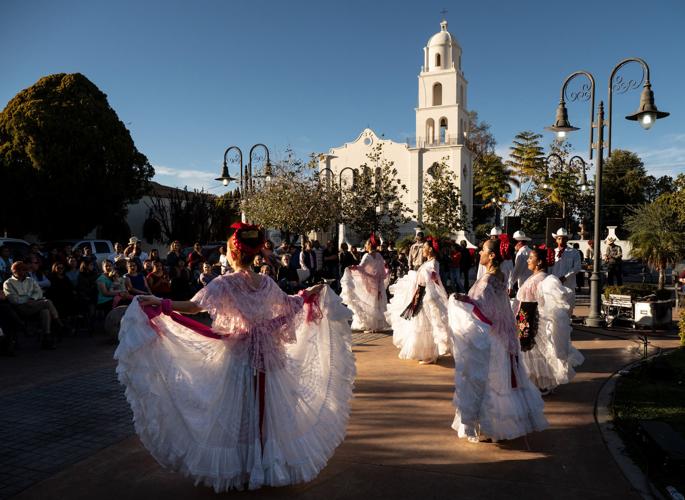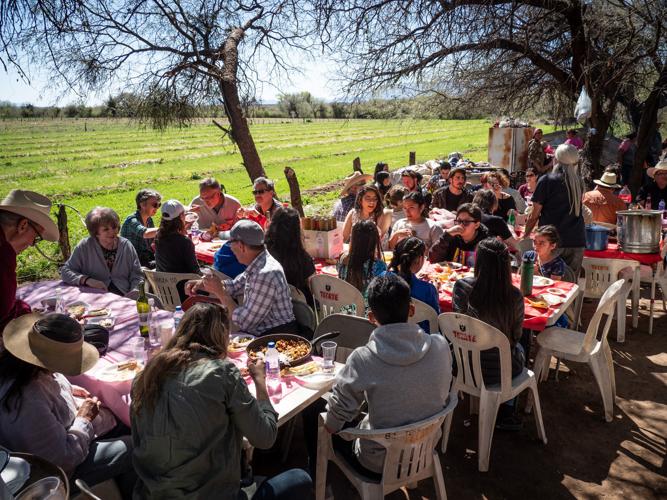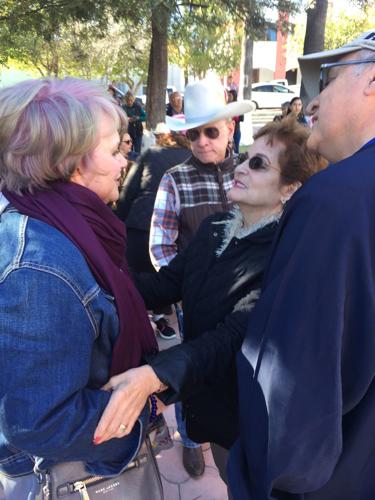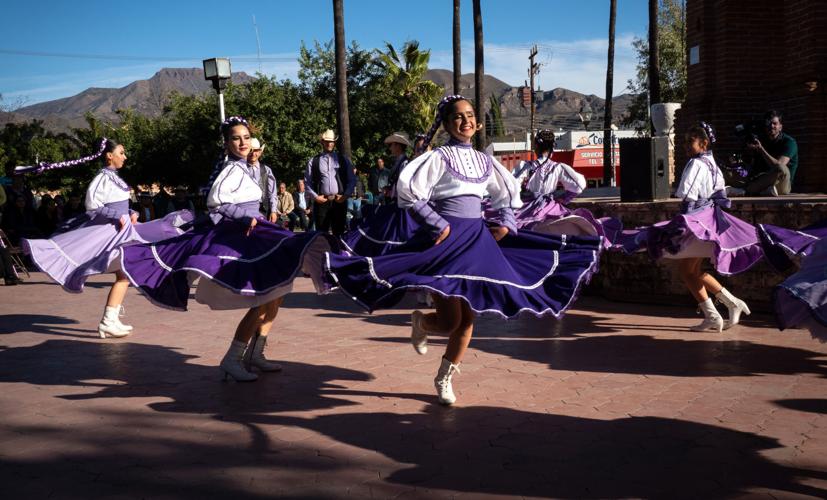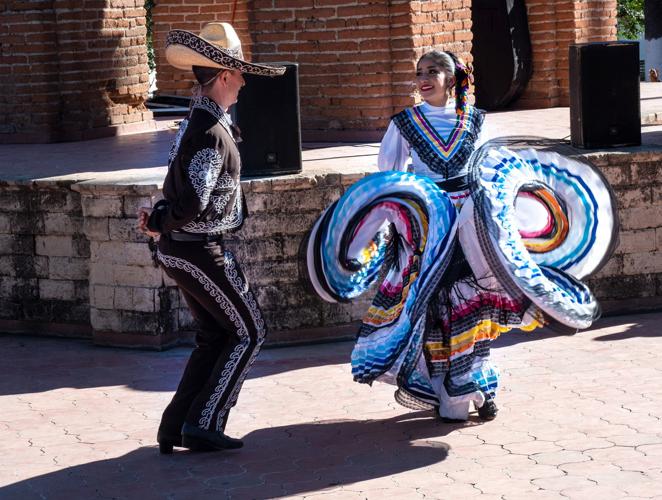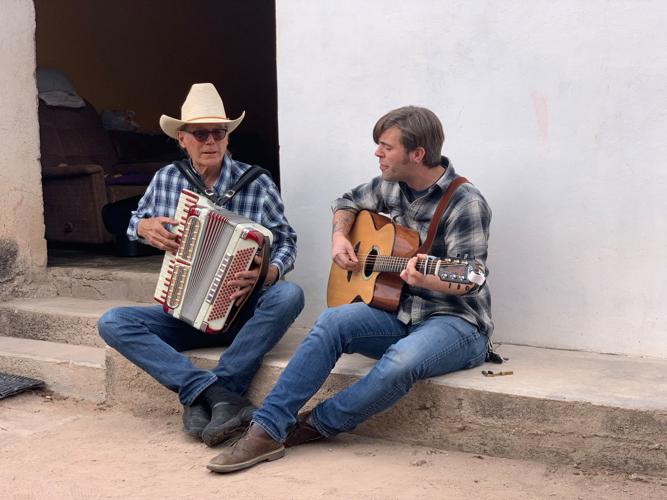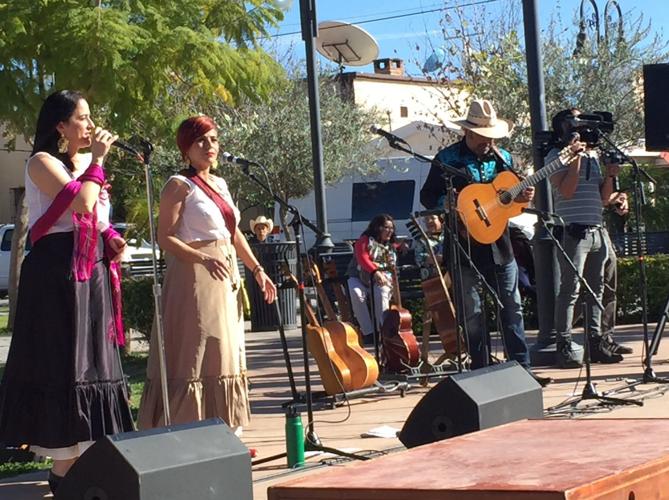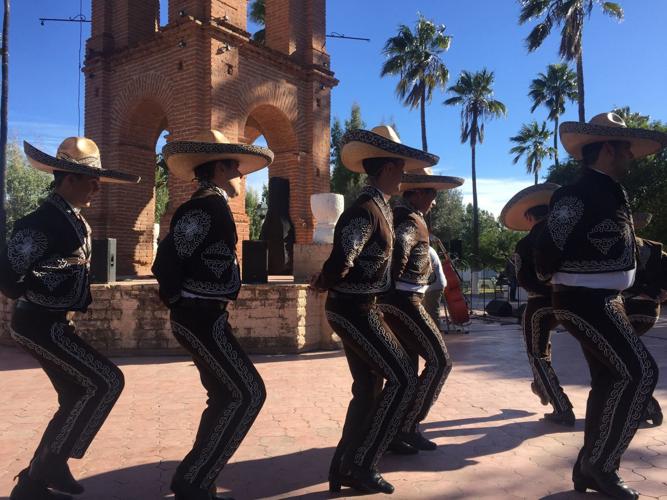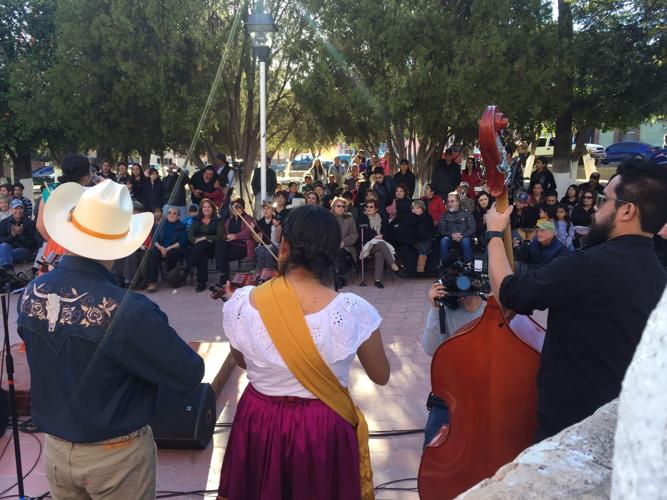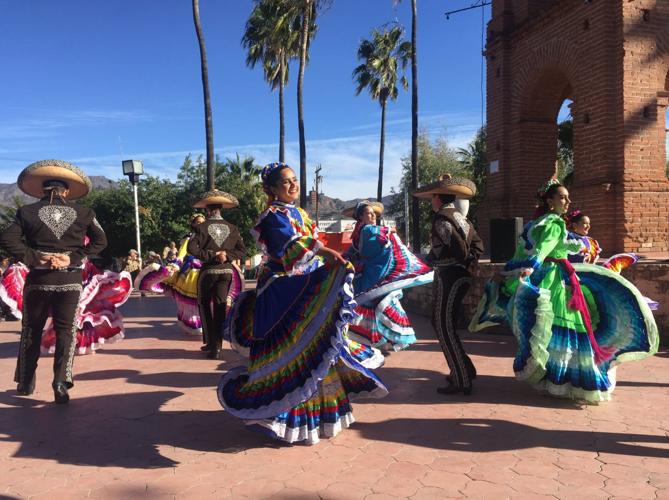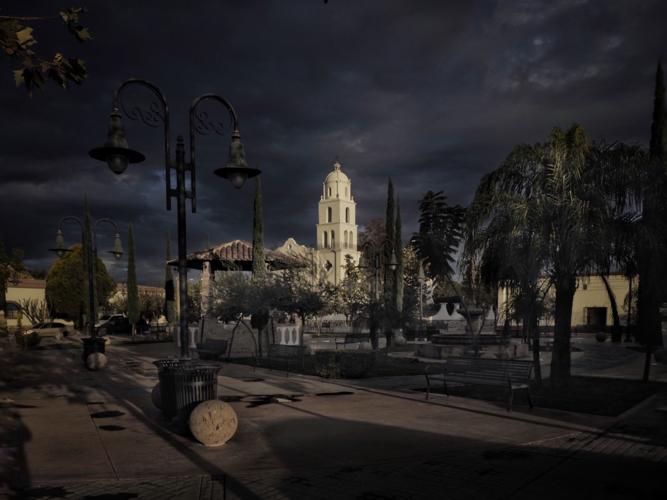As the bus headed north and the Naco Port of Entry disappeared in the southern distance, Tucson-born singer Linda Ronstadt comfortably reclined in the rear row as her emotions and newly minted memories from the past four days nestled inside her.
She had spent the weekend with a group of musicians and music-loving family and friends in Banámichi, Sonora, a small town along the Río Sonora several hours south of the U.S.-Mexico border. Her grandfather, Federico José María Ronstadt, was born nearby in Las Delicias, before migrating to Tucson in the early 1880s.
Ronstadt has previously visited this land — an accordion of jagged mountain edges on whose slopes saguaros and organ pipe cactus stand as silent sentinels and the lush valley floor is covered with fava beans, garlic, cottonwoods and palo verdes. The history and culture of the indigenous Ópata and Pima, Jesuit missionaries and Basque colonizers, and the Mexican ranching families courses through her soul like the water that runs through the valley.
Over the years, Ronstadt has created friendships and relationships with people whom she considers long-distant kin.

The folkloric dance group Xunutzi, made up of high school students and older dancers, performs on the plaza in Banámichi. The dancers are from the towns along the Río Sonora.
“Well, it’s so beautiful here and people are so nice,” she said softly over the low murmur of the bus that headed to Tucson last Monday evening. “And it’s just an ideal town. The people are so very cordial. They remember my dad and grandfather. I’ve met people who didn’t know my grandfather personally but remember his name and what he stood for. That means something.”
Being in Banámichi is something special for Ronstadt, who first visited the area with her father, Gilbert Ronstadt, before he died in 1995. Her connection to the land and the people is strong.
But now at 72, she no longer sings in public. She is dealing with the incrementally debilitating Parkinson’s disease, which was diagnosed in 2013. Ronstadt, considered one of pop music’s greatest voices and who was inducted into the Rock & Roll Hall of Fame in 2014, cannot easily travel.
This trip to the Rio Sonora, organized by longtime friends Bill and Athena Steen of Canelo, could be Ronstadt’s last. Then again, given her profound appreciation for the people and the culture of the Río Sonora, she’s likely to return again.

Bobby Ronstadt, left, and Peter Ronstadt played for the tour group in Cucurpe, Sonora, just east of Magdalena de Kino, Sonora. The tour group, which included Linda Ronstadt, were traveling to Banámichi, the birthplace of the Ronstadt patriarch, Federico José María Ronstadt. Photo taken Friday, February 15, 2019.
LASTING LEGACY
Ronstadt returned to Banámichi on a mission. She was joined by a group of 17 folkloric dancers, ranging in age from 8 to 20, and four adult singer-musicians from Los Cenzontles Cultural Arts Academy in San Pablo, California, north of Berkeley. Ronstadt has been a key supporter of the group for nearly 30 years. Also on the trip were her cousin Bobby Ronstadt and nephew Petie Dalton Ronstadt, both Tucson musicians and singers, and her longtime friend, pop-rock icon Jackson Browne from Los Angeles.
In addition, a film crew accompanied Ronstadt. Documentary filmmaker and actor James Keach (“The Long Riders,” “Walk the Line,” “Razor’s Edge”) is making two documentaries, one on Ronstadt and the other on Los Cenzontles. The Ronstadt documentary is expected to be a theatrical release and also would be shown on cable.
The trip was filled with impromptu singing and staged dances on the plazas of Banámichi and the neighboring town of Arizpe, where Juan Bautista de Anza, the 18th-century Basque explorer of California and New Mexico, is buried. On the bus, the Cenzontles students sang and strummed their stringed instruments; in the small town of Cucurpe, Bobby and Petie Ronstadt sat at a doorway and serenaded in English and Spanish during lunch; and on the second evening, Browne, with guitar in hand, joined Cenzontles’ vocalists Fabiola Trujillo and Lucina Rodriguez, singing lilting harmonies late into the evening in the dining room of the comfortable La Posada del Río Sonora, the colorful hotel facing the Banámichi plaza.

Members of the Los Cenzontles dance group, from San Pablo, California, perform on the plaza in Arizpe. Linda Ronstadt has been a longtime supporter of the group.
“The music of the countryside is best sung in the countryside,” said Eugene Rodriguez, founder and director of Los Cenzontles.
The musical and dance component of the trip reflected Ronstadt’s long love affair with Mexican music and culture imbued in her by her father, known to many as “Gibby.” She has supported Mexican music as a singer, collaborating with Tucson-born Mariachi Cobre and as a performer at the annual International Tucson Mariachi Conference as well as other mariachi festivals in the U.S. and in Mexico.
More than 30 years ago, Ronstadt, who has sung rock, country and American standards, released her landmark recording, “Canciones de Mi Padre.” It was a collection of classic Mexican songs backed by mariachi, inspired by Ronstadt’s childhood days, her music-loving father and a unique friend, Tucson-born icon musician and singer, Eduardo “Lalo” Guerrero. Having sold up to 10 million copies, “Canciones” is considered the best-selling non-English language record in the U.S. and served as Ronstadt’s platform to promote and preserve Mexican music worldwide.
In Arizpe, fans surrounded her, taking selfies as soon they unexpectedly spied her on the plaza on a cold, windy afternoon. “We all have her music,” said Alejandro Manteca Elías of Phoenix, who attended Salpointe Catholic High School with some of Ronstadt’s cousins, and who was with two siblings visiting family in Arizpe. “We grew up with her.”

Dancers with the Grupo Danza Xunutzi perform on the Arizpe plaza. The group performed along with the California-based dance and musical group Los Cenzontles.
But it’s Ronstadt legacy that makes its lasting impact on the students who were possibly on a trip of their lifetime.
Verenice Velazquez is a 20-year-old student at UC San Diego who sings, dances and plays several instruments with Los Cenzontles, which she joined when she was 7. It was her first time performing with Los Cenzontles in Mexico, the country where her parents were born. Being with Ronstadt and sharing Mexican music in Mexico was beyond special, she said.
“It means a lot. It’s really amazing to just be able to know these traditions and perform them in California and it’s even more amazing to bring them back to Mexico where they are from,” she said during a lunch break on the bank of the Río Sonora on the final day.
“It’s a dream to be on this trip with such a well-known artist that my parents know really well and listen to her music.”

Linda Ronstadt, facing in at left, and her traveling companions have lunch at a ranchito outside of Banámichi. The Sonora River valley is filled with small ranches that raise cattle, crops and distill bacanora, Sonoran tequila.
MAGICAL CONNECTION
The magic of Banámichi, where years of tradition remain as strong as the tiny red-hot chiltepines that grow wild, and the fiery bacanora distilled from Sonoran agave plants, has lured Ronstadt back and will continue to pull on her emotions.
“What I remember is seeing a house on the corner,” she said as she recalled a memory from a visit with her father. “We looked at the church. He said his grandparents were buried there in that church. (She couldn’t remember some details and names and she chuckled at herself a bit.) Anyway, first thing I did was look at the church and then I saw the house to the right of it on the corner and I thought if that was our house.”
Her emotions haven’t changed over the years and several visits, she said.
“I still have that same sense of pride. That is where I’m from. This is what I stand for,” she said. “There is something real special and magical about the Rio Sonora valley. It has a different mix of cultures. It’s tangible.”
Ronstadt’s connection to the Río Sonora is similar to that of countless families in Tucson and Southern Arizona. Arizona license plates are common, and it’s not rare to see a decal with the University of Arizona’s block “A” on a pickup decorated with horseshoes hauling supplies or livestock. Families go back and forth from the Río Sonora valley to the deserts and mountains of Arizona.
Ronstadt explained it this way: “There’s kind of homesickness that we all have inherited genetically. Maybe I inherited some from my great-grandfather Friedrich August when he came to Mexico from Germany or my great grandmother (Margarita Redondo Ronstadt) who was from Mexico. ... But maybe she had some homesickness leaving her comfortable hacienda.”
Bill Steen, whose grandfather was also born in Banámichi and who grew up in Tucson with the Ronstadt family, was pleased that the tour, with all its parts, came together. The difference between this trip and previous ones he’s accompanied Ronstadt on, he said, is that the “potential wildness that teetered on falling into complete chaos fell into perfect harmony.”
For Ronstadt, her visits to the Río Sonora are indeed full of harmony. The memories abound. And from this last and possibly final trip, she said she’ll keep as her favorite image when the dancers from both groups joined in an impromptu, joyful celebration to the song, “La Bamba,” in the cold Arizpe air.
“We have lots to learn from each other,” she said.
But will this be her last trip? Will she return?
“If I can hitch a ride,” she said with a laugh.

Two members of the Grupo Danza Xunutzi perform on the Arizpe plaza in Sonora.

Two members of Los Cenzontles folkloric dance and music group peer out from the front doors of the hotel La Posada del Río Sonora toward the plaza in Banámichi, Sonora, Saturday, Feb. 16. The group from San Pablo, Calif., traveled to Sonora with Linda Ronstadt, a longtime supporter of the cultural and arts group.

Los Cenzontles of San Pablo, Calif., perform on the plaza in Banámichi, Sonora, Saturday, Feb. 16. The youth dance and musical group traveled to northern Sonora with Linda Ronstadt, a longtime supporter of the group.

Fabiola Trujillo, left, Lucina Rodriguez, middle, and Eugene Rodriguez of Los Cenzontles perform on the plaza in Banámichi. The group is from San Pablo, Calif. Eugene Rodriguez founded the music and dance group in 1987. Both women have been with the group since they were little girls.

The folkloric dance group Xunutzi, made up of high school students and older dancers, perform on the plaza in Arizpe, Sonora, on Sunday, Feb. 17, 2019. The dancers are from the towns along the Río Sonora. The group has won regional and national dance competitions in Mexico.

Los Cenzontles perform in front of Linda Ronstadt and an audience in Arizpe, Sonora, Sunday, Feb. 17.

The folkloric dance group Xunutzi, made up of high school students and older dancers, perform on the plaza in Arizpe, Sonora, on Sunday, Feb. 17, 2019. The dancers are from the towns along the Río Sonora. The group has won regional and national dance competitions in Mexico.

Night descends on the plaza in Banámichi, Sonora, the birthplace of Linda Ronstadt’s grandfather. Many Southern Arizonans trace their ancestral roots to the towns along the Río Sonora.
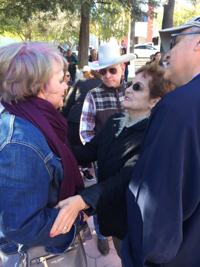
In Arizpe, Sonora, Linda Ronstadt, right, is approached by longtime fans, Dr. Jesus Antonio Manteca Elias of Chicago, his sister Edna Manteca Verdugo of Tucson and their brother Alejandro Manteca Elías of Phoenix. The three were visiting their mother, Clementina Elías Manteca in Arizpe and were unaware that Ronstadt was in town.
Photos: Tucson-native, Grammy-winner Linda Ronstadt

Linda Ronstadt arrives at Tucson International Airport on Sept. 16, 1976 for a benefit concert for the Arizona-Sonora Desert Museum.

Linda Ronstadt arrives at Tucson International Airport on Sept. 16, 1976 for a benefit concert for the Arizona-Sonora Desert Museum.

Linda Ronstadt signs autographs at Tucson's Symphony Cotillion Ball in 1977.

Linda Ronstadt make a face while signing dozens of autographs at Tucson's Symphony Cotillion Ball in 1977.

Linda Ronstadt at Tucson's Symphony Cotillion Ball in 1977.

Linda Ronstadt and the Stone Poneys at Minus One Coffeehouse on 6th Street Nov. 24, 1966.

Linda Ronstadt and the Stone Poneys at Minus One Coffeehouse on 6th Street Nov. 24, 1966.

Ad for a Linda Ronstadt concert at TCC in 1972.

Linda Ronstadt appearance in Tucson in September, 1976.

Linda Ronstadt concert in Tucson, February, 1975.

Linda Ronstadt in concert at the Tucson Community Center on Sept. 16, 1976. The original negatives are missing from the archives, but the photo assignment and contact sheets of all the outtakes remain.

Linda Ronstadt in concert on Feb. 9, 1975 at Tucson Community Center. Note the changed spelling on the original photo request.

Linda Ronstadt in concert at McKale Center on Nov. 2, 1980. The original negatives are missing from the archives, but the contact sheets of all the outtakes remain. Note the comment on the photo assignment.

Linda Ronstadt in concert at Tucson Community Center on Sept. 16, 1976. The original negatives are missing from the archives, but the contact sheets of all the outtakes remain.

"Heart Like a Wheel" by Linda Ronstadt, the album that started it all and went Platinum.

FILE - This Feb. 20, 1977 file photo shows singer Linda Ronstadt is flanked by Ringo Starr, left, and Paul Williams after she was named best pop singer for her "Hasten Down the Wind" at The 19th Annual Grammy Awards in Los Angeles. A documentary, “Linda Ronstadt: The Sound of My Voice,” will premiere on CNN on New Year's Day. (AP Photo)

FILE - In this 1976 file photo, California Gov. Edmund Brown Jr. and singer Linda Ronstadt stand with members of the Eagles rock group during a concert in Maryland. Brown and Ronstadt dated for several years before going their separate ways. Brown, who was re-elected to the governor's office in 2010, leaves office Jan. 7, 2019, after a record four terms in office, from 1975-1983 and again since 2011. (AP Photo/Karin Vismara, File)

FILE - This Aug. 5, 1979 file photo shows Linda Ronstadt performing during the Lowell George Tribute in Los Angeles. Now at 74, the 10-time Grammy winner and Rock and Roll Hall of Famer has been recognized as a “Legend” at the 33rd annual Hispanic Heritage Awards. (AP Photo)

Singer Linda Ronstadt performs at the Providence Civic Center in Providence, R.I., on Aug. 8, 1978. (AP Photo)

Singer Linda Ronstadt visits British rocker David Bowie backstage during his break in the Broadway play "The Elephant Man," at the Booth Theater in New York, Dec. 5, 1980. (AP Photo/Richard Drew)

Actor Kevin Kline, left, arrives at the premier of the film version of "The Pirates of Penzance" with his co-star Linda Ronstadt in New York, Feb. 18, 1983. (AP Photo/G. Paul Burnett)

Linda Ronstadt singing at Mariachi Espectacular at Tucson Community Center in on May 9, 1986.

Linda Ronstadt sings to her father, Gilbert, at the Mariachi Espectacular concert to close the Tucson International Mariachi Festival on May 9, 1986.

Linda Ronstadt at the Mariachi Espectacular concert to close the Tucson International Mariachi Festival on May 9, 1986.

Linda Ronstadt (left), Emmylou Harris and Dolly Parton (right) rehearse for the annual Country Music Association awards show at the Grand Ole Opry House in Nashville on Sunday, Oct. 13, 1986. The trio will perform during the show on Monday. (AP Photo/Dan Loftin)

Linda Ronstadt singing with her father, Gilbert, at Mariachi Espectacular on April 24, 1987 at Tucson Community Center.

Linda Ronstadt in Los Angeles on Dec. 7, 1987.

Linda Ronstadt in Los Angeles on Dec. 7, 1987.

Linda Ronstadt in Los Angeles on Dec. 7, 1987.

Linda Ronstadt with Mariachi Vargas at Centennial Hall on Feb. 11, 1988.

Linda Ronstadt with Mariachi Vargas at Centennial Hall on Feb. 11, 1988.

Linda Ronstadt, center, during an interview about a school exchange program in Arizpe, Mexico, in October, 1989.

Chuck Berry shares the stage with Linda Ronstadt during his 60th birthday celebration at the Fox Theatre in St. Louis, Mo., Oct. 17, 1986. Ronstadt is one of the guests during the concert, which was filmed for a motion picture documentary titled "Chuck Berry Hail! Hail! Rock 'n' Roll." (AP Photo/James A. Finley)

Actor Robert Wagner pictured with singer Linda Ronstadt rehearsing on the set of "Saturday Night Live," Dec. 9, 1989. (AP Photo/Timothy Clary)

Linda Ronstadt, one of the Hall of Fame's first five inductees, brought mariachi music to the masses with two popular LPs.

In the 1924 photo, Federico Ronstadt and his wife, Lupe, pose with their four sons, (from left) Bill, Edward, Gilbert and Alfred. Gilbert is Linda's father.

FILE - Singer Linda Ronstadt appears at the 26th Annual Grammy Awards in Los Angeles on Feb. 28, 1984. Now at 74, the 10-time Grammy winner and Rock and Roll Hall of Famer has been recognized as a “Legend” at the 33rd annual Hispanic Heritage Awards. (AP Photo, File)

Grammy winner Linda Ronstadt teams up with veteran arranger/conductor Nelson Riddle to perform classic ballads in Linda Ronstadt in concert with the Nelson Riddle Orchestra. Featuring songs from Ronstadt's hit LP "What's New" in 1998.

Chuy Rodriguez of Los Camperos de Nati Cano's Chuy Rodriguez sings with Linda Ronstadt during the Mariachi Conference Espectacular concert at the Tucson Arena on Friday, April 24, 2009.

Tucsonan Linda Ronstadt performs with Sam Bush at the Berger Performing Arts Center here on June 12, 2002.

Linda Ronstadt performs during the Mariachi Espectacular concert in the Tucson Arena on Friday, April 24, 2009.

This Sept. 17, 2013 photo shows American musician Linda Ronstadt poses in New York to promote the release of her memoir "Simple Dreams."


Tucson native and Rock and Roll Hall of Fame inductee Linda Ronstadt talks with Jeff Haskell during the resurrected Sunday Evening Forum at the Fox Theatre, 17 W Congress St. The Grammy award winner and pop and country music icon recently announced she has been diagnosed with Parkinson Disease. In addition to being inducted in the Hall of Fame she was also honored with the National Medal of Arts. The interview series, in which the moderator takes written questions from the audience, only recently returned in March after a 30-year hiatus. Admission was free and no reservation were accepted. The photo was taken on Sunday, October 5, 2014, in Tucson, Ariz.

President Obama shakes hands with musician Linda Ronstadt in the East Room of the White House in Washington, Monday, July 28, 2014, where he presented her with a 2013 National Medal of Arts. (AP Photo/Charles Dharapak)

Front row from left, Susan Pompeo, 2019 Kennedy Center Honorees Michael Tilson Thomas, Linda Ronstadt, Sally Field, Joan Ganz Cooney, Lloyd Morrisett and Kennedy Center President Deborah F. Rutter, back row from left, Secretary of State Mike Pompeo, 2019 Kennedy Center Honorees Philip Bailey, Verdine White, Ralph Johnson, characters from "Sesame Street," Abby Cadabby, Big Bird, and Elmo, Kennedy Center Chairman David M. Rubenstein, Ricky Kirshner and Glenn Weiss pose for a group photo following the Kennedy Center Honors State Department Dinner at the State Department on Saturday, Dec. 7, 2019, in Washington. (AP Photo/Kevin Wolf)

Maria Muldaur, left, and Linda Ronstadt onstage at the 19th Annual Movies For Grownups Awards at the Beverly Wilshire Hotel on Saturday, Jan. 11, 2020, in Beverly Hills, Calif. (Photo by Richard Shotwell/Invision/AP)

Grammy-winning singer and Tucson native Linda Ronstadt stands before a Rock Martinez mural of her as she is honored during the renaming ceremony of the Tucson Music Hall, which became the Linda Ronstadt Music Hall, in 2022.

For years, Linda Ronstadt railed against the razing of the barrio to make way for the Tucson Convention Center. Now her name has become a part of it with the renaming of the Tucson Music Hall to the Linda Ronstadt Music Hall.
Tucson native, Emmy and Grammy winner Linda Ronstadt honored at a ceremony before the International Mariachi Conference's Espectacular Concert with the renaming of the Tucson Music Hall as The Linda Ronstadt Music Hall. Video by Kelly Presnell / Arizona Daily Star



